Nuclear bombs may be used to target killer asteroids and send them on a non-Earth-bound trajectory – this is what the EU Commission has tasked a group of Russian scientists to determine, as part of the NEOShield project. The blast would cause the outer layers of the asteroid to evaporate and the object would by pushed off course, thus missing the Earth.
The NEOShield project (Near Earth Object Shield), an international collaboration involving thirteen partners from research institutions and industry, was granted FP7 funding by the European Commission in 2014 to investigate ways of preventing impacts of NEOs using space-based deflection technologies.
Acccording to NASA, Near Earth Objects (NEOs) are asteroids and comets that have been nudged by the gravitation attraction of planets nearby into orbits that bring them into Earth’s neighbourhood.
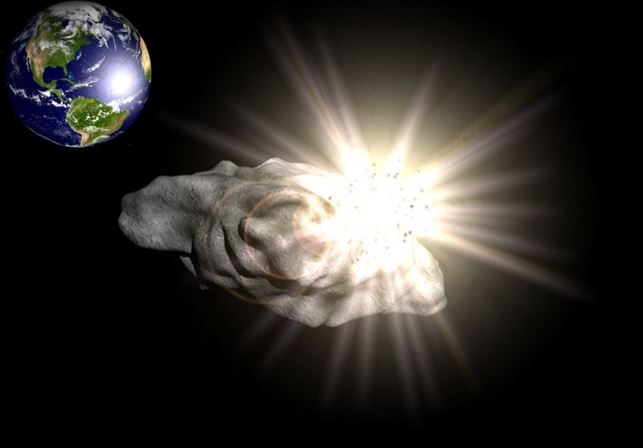 Nuclear Bast Deflection: a nuclear bomb explodes very close to the killer asteroid. The blast causes the outer layers of the asteroid to evaporate, acting just like rocket fuel, pushing the object on a different course, away from Earth. (Image: neoshield.net)
Nuclear Bast Deflection: a nuclear bomb explodes very close to the killer asteroid. The blast causes the outer layers of the asteroid to evaporate, acting just like rocket fuel, pushing the object on a different course, away from Earth. (Image: neoshield.net)
Collisions in Earth’s history
The phenomenon of collisions has played a major role in forming the planets we observe in our solar system today.
Comets and asteroids brought water and organic materials – which were vital for the development of life – to the early Earth.
However, later impacts probably played a major role in mass extinctions, and today they pose a small but significant threat to the future of human civilization.
Collisions of NEOs with our planet have occurred frequently over geological history. It is an undeniable fact that major collisions with comets and asteroids with Earth will continue happening at unpredictable, irregular intervals in the future.
Thousands of NEOs discovered
As a result of directed efforts and modern observing techniques, thousands of NEOs have been discovered over the past two decades and the reality of the impact hazard has been laid bare.
Even comparatively small impactors can cause significant damage. The asteroid that exploded in February 2013 over the city of Chelyabinsk in Russia was only 18 metres (59 feet) wide, yet it produced a blast wave that damaged seven thousand buildings and caused injuries to approximately 1,500 people.
The European Commission, on the day it approved FP7 funding for the NEOShield project, said in a statement:
“The potentially devastating effects of an impact of a large asteroid or comet are now well recognized, although we can only speculate on the complex disruptive effects a major impact would have on today’s technically sophisticated and highly networked world.”
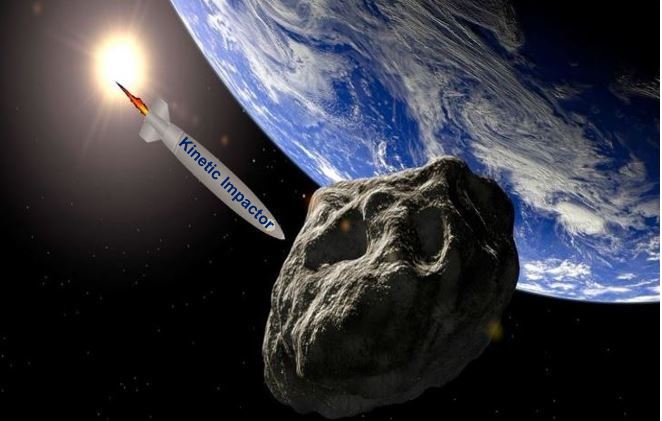 Kinetic Impactor Method: as the impactor (a rocket/spacecraft) crashes into the asteroid at ultra-high speed, the impactor’s momentum is transferred to the NEO, causing a change in velocity, and thus making it deviate from its course slightly.
Kinetic Impactor Method: as the impactor (a rocket/spacecraft) crashes into the asteroid at ultra-high speed, the impactor’s momentum is transferred to the NEO, causing a change in velocity, and thus making it deviate from its course slightly.
We need to know more about NEOs
In order to successfully deflect an Earth-bound celestial object, we need accurate knowledge of its physical characteristics, including its density, rotation rate, shape, size, and internal structure composition.
We need to know as much as possible about the ‘enemy’, the European Commission says. An important task is to analyse existing observational data from an asteroid-defence point of view.
We also need to determine the best way to observe potentially threatening NEOs to provide mitigation-relevant information as rapidly and efficiently as possible, and to study what types of space mission could be used to determine relevant properties.
NEOShield’s mitigation missions under investigation include the ‘kinetic impactor’, where a spacecraft is used to deflect an asteroid by crashing into it, thus transferring momentum so as to slightly alter its orbit and cause it to miss the Earth.
NEOShield partners are carrying out laboratory trails in which projectiles are fired at pretend asteroids. The results of such experiments, combined with simulations and computer modeling, will give us insight into what would happen if we launched a kinetic impactor deflection mission.
Using the gravity-tractor method
Scientists are looking into using a weak gravitation force between the spacecraft and the asteroid – a gravity tractor.
If a spacecraft can get near enough to the NEO, the tiny but significant attraction between the asteroid and the spacecraft could work like a tow rope. If it were done early enough, changes in the orbital velocity of the asteroid of just a few inches per second or less might be enough to prevent a catastrophic collision with the Earth.
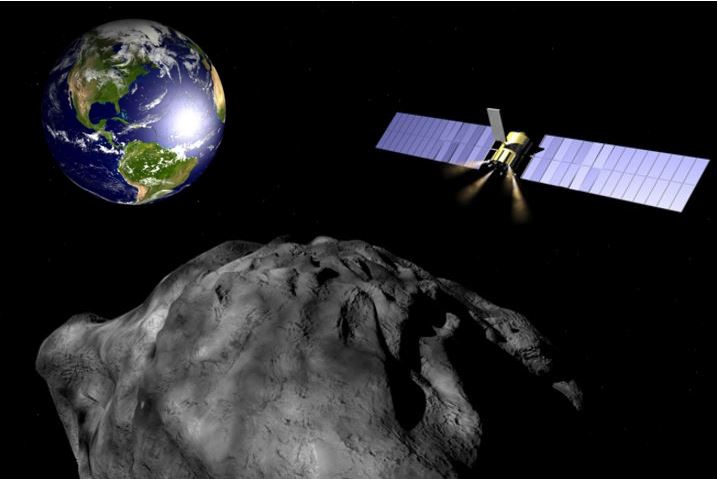 The gravity tractor is an idea that was first proposed by astronauts Ed Lu and Stan Love. The beauty of this method is that we don’t need much information about the asteroid to allow the outcome to be accurately predicted. We only need data on its mass. (Image: neoshield.net)
The gravity tractor is an idea that was first proposed by astronauts Ed Lu and Stan Love. The beauty of this method is that we don’t need much information about the asteroid to allow the outcome to be accurately predicted. We only need data on its mass. (Image: neoshield.net)
Regarding using the gravity tractor method the European Commission said:
“This method would be relatively slow but would have one big advantage: contact with the surface of the NEO is not necessary thus no information about the interior structure or surface properties of the object is required to predict the outcome.”
A nuclear bomb
If we were faced with an Earth-bound killer asteroid and had a short warning time, the methods mentioned above would probably not solve the problem. The most powerful force we could apply – given our current level of technology – would be a nuclear explosion.
The European Commission said this possibility – nuclear explosion – is being undertaken as part of the NEOShield project, and emphasized “We obviously have no plan to test a mission of this kind.”
The European Commission says it expects two main results from the NEOShield project:
1. A better understanding of the mitigation-relevant physical characteristics of near-Earth objects, and the type of objects that pose the greatest threats to our planet and that could be used as targets in ‘realistic technically and financially feasible deflection test missions.’
2. A detailed description of the best and most appropriate instrumentation for the provision of crucial pre-cursor mitigation-relevant data from space- and ground-based reconnaissance observations.
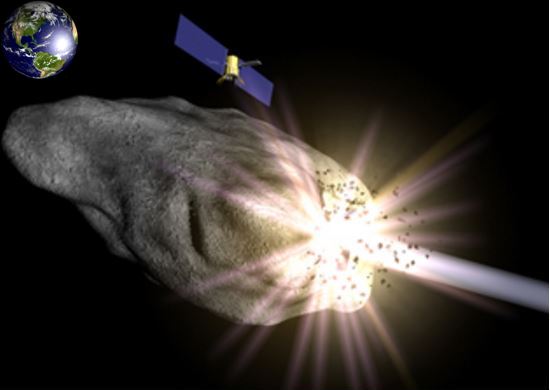 Combined Kinetic Impactor and Explosive: NEOShield is also looking at combining the kinetic impactor method with an explosive. (Image: neoshield.net)
Combined Kinetic Impactor and Explosive: NEOShield is also looking at combining the kinetic impactor method with an explosive. (Image: neoshield.net)
Firing nuclear weapons in space illegal
According to the Outer Space Treaty of 1967, stationing or firing a nuclear weapon in outer space is illegal. However, Russian scientists involved in this latest research believe that if our lives depended on it, the law would be waivered.
Getting a nuclear bomb to explode on an Earth-bound killer asteroid would have one of three possible effects, the researchers said:
1. The blast would push the asteroid in a different direction, and hopefully it would not crash into the Earth.
2. The asteroid would lose some of its mass, which would change its speed and trajectory – this would change its course.
3. A combination of number 1 and 2 above would occur.
The Central Scientific Research Institute of Machine Building, more commonly known as TsNIImash, Russia’s leading space technology developer, said in a press statement:
“Work was distributed among various participants from different countries and organisations, and work on deflecting dangerous space objects with nuclear explosions was conducted by Russia.”
According to TsNIImash, which is part of Roscosmos (Роскосмос), the governmental body responsible for the Russian space science program and general aerospace research, nuclear weapons have a key role to play in defending our planet from dangerous NEOs, even if the 1969 Treaty remains unchanged. “If the asteroid threat becomes a matter of serious damage or even the very existence of life on Earth, that ban would naturally be lifted,” it predicted.
What are the Americans doing?
Earlier this month in the United States, NASA announced the setting up of an asteroid defense team aimed at preventing dangerous NEOs from crashing into Earth.
The focus of NASA’s Planetary Defense Coordination office will be to send spaceships to asteroids and try to alter their trajectory, i.e. get them to move in a different direction.
The new team will be tasked with finding and describing NEOs, as well as coordinating effective and appropriate defense responses to any celestial body that threatens to harm us.
There are many NEOs out there
According to NASA, we know of 13,500 NEOs of all sizes. Scientists are discovering more than 1,500 new ones annually.
The vast majority (90%) of all the NEOs we know of have a width greater than 1 kilometer (0.62 miles). NASA’s team is concentrating on finding NEOs that are at least 140 metres (450 feet) wide.
One decade ago, NASA was tasked with finding 90% of NEOs wider than 140 metres by the end of 2020. It says 25% of them have been detected so far.
John Grunsfeld, Associate administrator for NASA’s Science Mission Directorate in Washington, said:
“Asteroid detection, tracking and defense of our planet is something that NASA, its interagency partners, and the global community take very seriously.”
“While there are no known impact threats at this time, the 2013 Chelyabinsk super-fireball and the recent ‘Halloween Asteroid’ close approach remind us of why we need to remain vigilant and keep our eyes to the sky.”
Sending an asteroid boulder into Moon orbit
NASA is currently developing a robotic mission which in the next decade will visit a near-Earth asteroid. When it gets there, it will pick up a large, multi-ton boulder and take it towards the Moon, where it will be placed in a Moon orbit.
The aim of the mission is to determine whether a gravity tractor approach is feasible and what it involves.
If that mission is successful, it would mean that humans had the technology to drag an Earth-bound NEO off its current course, i.e. deflect it so that it would miss Earth.
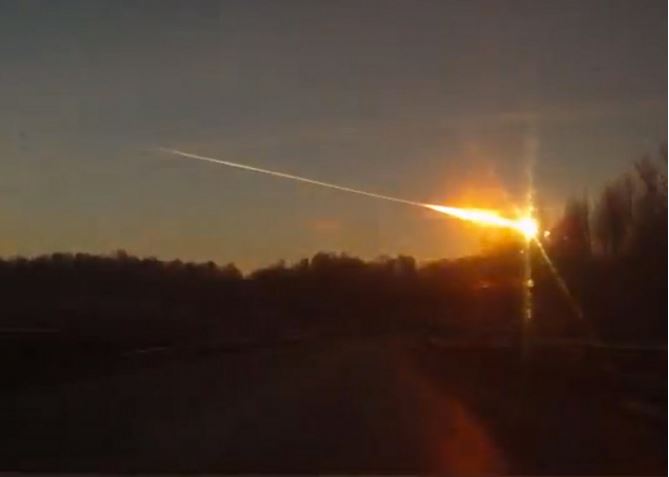 The relatively small Chelyabinsk meteor arrived undetected – nobody knew about it until it hit our atmosphere. (Image: serc.carleton.edu)
The relatively small Chelyabinsk meteor arrived undetected – nobody knew about it until it hit our atmosphere. (Image: serc.carleton.edu)
We need better detection of threats
Our ability to detect rapidly incoming celestial objects needs to improve. The Chelyabinsk meteor (mentioned above) was undetected before its atmospheric entry, partly because its radiant was close to the Sun. The ‘radiant’ is the point in the sky from which a meteor appears to originate.
The Chelyabinsk meteor came in at a speed of 40,000 to 42,900 mph (60,000 to 69,000 km/h). As nobody saw it coming there was no time to organize a response. Even without the technology to change its trajectory or blow it up in space, a couple of days’ warning would give the authorities time to evacuate an area.
The blast from the Chelyabinsk meteor was the equivalent of twenty to thirty Hiroshima bombs. Fortunately, as it exploded several miles above ground, most of the energy was absorbed by the atmosphere.
 What would happen today if we were struck by the meteor that hit Earth 65 million years ago and brought about the end of the dinosaur?
What would happen today if we were struck by the meteor that hit Earth 65 million years ago and brought about the end of the dinosaur?
Surely, before we make gravity-tractor spaceships and spend millions on getting nuclear weapons ready to blow up on asteroids, we should be able to know they are coming – all of them. How useful would all that hi-tech equipment be if there are still NEOs out there that we only know about when they hit our atmosphere?
An Earth-bound object does not have to be that big to destroy us. The one that scientists think was the main contributor to the extinction of the dinosaur – it crashed near the Yucatan peninsula in the Caribbean 65 million years ago – was just 7 to 8 miles (11 to 13 km) wide.
Geoscientist Brian Toon, who works at the University of Colorado Boulder, thinks that if a collision like the Yucatan one struck Earth today, billions of people would die. Most of the animals and much of Earth’s vegetation would also be destroyed. He believes a few people might live, but they would find it extremely difficult to survive.
Scientists estimate that a 60 mile (96.5 km) wide asteroid would destroy all life on Earth (see video at bottom of page).
The Tunguska Event 1908
In 1908, a meteor explosion destroyed 770 square miles (2,000 km2) of forest near the Stony Tunguska River, a very sparsely-populated region in Siberia, Russia.
Scientists believe the meteor exploded about 10km (6 miles) above ground. The explosion had the force of more than 1,000 Hiroshima bombs. The meteor was between 60 to 90 metres (200 and 620 feet) wide.
This was the largest impact event in modern history, i.e. ‘recorded’ history. Had the meteor exploded over London today, millions of people would have died and virtually every building would have been destroyed.
One of the few witnesses to see the Tunguska Event, farmer Sergei Semenov, is quoted by History Rundown as saying:
“I was sitting in the porch of the house at the trading station of Vanovara at 7 a.m. and looking towards the north … suddenly the sky appeared like it was split in two, high above the forest, the whole northern sky appeared to be completely covered with blazing fire.”
“At that moment I felt a great wave of heat as if my shirt had caught fire… after a minute, there was a loud bang in the sky, and I could hear a mighty crash. Subsequently, I was fiercely thrown to the ground about 5-6 meters away from the house and for a minute or two I lost my consciousness.”
Video – Size of asteroid to destroy all life on Earth
How big would a killer asteroid have to be to destroy all life on Earth. Scientists estimate it would have to be about 60 miles (96.5 km) wide.
